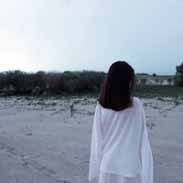Euro Art Quiz Flashcards
Unlock all answers in this set
Unlock answersquestion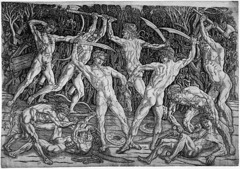
Battle of the Nudes 1465-1470 60 x 20 in

answer
Antonio del Pollaiuolo -Statuettes of religious subjects were still popular but humanist art patrons began to collect bronze of Greek and Roman subjects. -Sculptors began casting small copies of classic works -This engraving reflects the interests of renaissance scholars -The study of classical sculpture and the anatomical research the leads to greater realism as well as the artist's technical skill in fine work on the metal plate. -his only known but highly influential print -a study in composition involving the human figure in action. -The naked men fighting each other ferociously against a tapestry like background of foliage seem to have been drawn from a single model in a variety of poses, many of which were taken from classical sources. - much of the engraving's fascination lies in how it depicts muscles of the male body reacting under tension.
question
The Expulsion from Paradise 1427 (took 4 days) 7 x 3 ft

answer
Masaccio -It was painted for the Brancacci Chapel in Santa Maria del Carmine, Florence, Italy. The fresco was influential for its realism, especially the simplicity and three-dimensionality of the figures, and for the dramatic depiction of the plight of Adam and Eve. -Masaccio's technique shows the roughness and lack of grace that was said by Vasari to be part of his character. Here Adam and Eve walk through the Gate of Paradise into the harsh emptiness beyond, as directed by an angel. -They have eaten from the Tree of Knowledge, and have learned of their mortality. Masaccio, by using a revolutionary deep shadowing that created mass in the figures, implied that they walk the earth as normal man and woman. Here, the painter's style suited the subject, and gave it life. -generic faces for Adam and Eve
question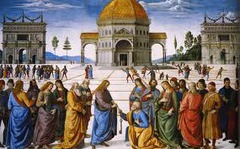
Delivery of the Keys to Saint Peter 1481 11 x 18 ft

answer
Pietro Perugino -portrayed an event providing biblical support for the supremacy of papal authority. -Christ's giving the keys of the kingdom of heaven to the apostle Peter. Peter then became the first bishop of Rome. This is a very significant and important event in a biblical sense as well as a historical event that took place at the Vatican, Rome. - one of the greatest paintings from the second half of the 15th century because of its simplicity and clarity of composition. -The key has a three-fold symbolic meaning: it indicates ownership and authority; it is a metaphor for a new life, the door to which it can open; and it represents a house. -As a master of the Early Renaissance, Perugino emphasized the architectural structure of the piazza and polygonal temple over the figures. -based on a grid system -everything is parallel
question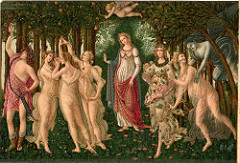
Primavera/Spring 1478-1482 7 x 10 ft

answer
Sandro Botticelli -It is Spring, Nature's favorite season. The three Charites (Graces) are dancing, a Nymph (Chloris) spreads flowers. It's time for a new erotic adventure represented by Aphrodite (Venus) and her flying son Eros (who uses his bow). -scene is framed by a beautiful verdure and flowers. The inanimate things, like the human beings, all speak of love and happiness. -Botticelli always painted in fresco or distemper, and he did not seek the supple modeling that painting in oil affords. -he was influenced by Pollaiolo; he observed Nature with the eyes of a goldsmith; and he painted his works as if he had to set each figure in gold-wire. -oranges in the trees for the Medici family
question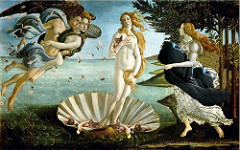
Birth of Venus 1486 6 x 9 ft

answer
Botticelli -The work demonstrates Botticelli's mastery of sinuous line and supple form. -The blowing characters are the Winds; the woman with a mantle is the Earth who will cover Venus with the flowers and fruits of the earth. -The painting is about a Classical myth: Venus, the goddess of love has been born from the sea, and is being blown to shore by Zephyrus, god of the winds. -a set of Christian associations can be seen. Venus's modesty, despite her nudity, and her pose refer to standard portrayals of the Virgin Mary. -This work was originally paired with another Renoir work entitled A Dance in the City. Renoir painted these two works for a Parisian art merchant. The work expresses Renoir's taste for abundant and indulged women. -Zephyrus is recognizable as an angel, while the figure on the right refers to another religious subject: specifically the way St. John the Baptist is usually pictured. -shows divine love and birth of beauty
question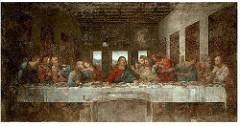
The Last Supper 1495-1498 15 x 29 ft

answer
Da Vinci -emphasis on grid system -4 groups of 3 with Jesus at the center -Jesus has no feet because of the door -Leonardo da Vinci was working based on the few known documents which describe this meal. -Leonardo da Vinci rearranged what was *said* about this important event, in order to convey his own thoughts and feelings on the subject. Part of why Leonardo's version was so famous immediately was that he had chosen a very unusual way to portray the scene. Judas was always shown off in a corner, sulking, away from the rest of the disciples. This is what the Dominicans thought they were getting. When they instead got this \"violent\" version with the disciples all screaming and yelling, the monks were not exactly pleased. It created a lot of publicity. -In common with other depictions of The Last Supper from this period, Leonardo adopts the convention of seating the diners on one side of the table, so that none of them have their backs to us.
question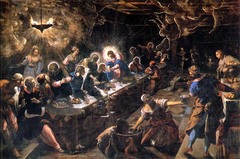
The Last Supper 1592-1594 10 x 19 ft

answer
Tintoretto -epitomizes Mannerism by taking Jesus and the table out of the middle of the room. -He showed all that was happening, in sickly, disorienting colors. He painted a scene of confusion that somehow separated the angels from the real world. He had removed the world from God's reach. -Christ in this work is at the centre -- but the table is at an angle. The overall effect is artificial, unreal, unearthly -- notice too how the everyday mixes with the supernatural. -Tintoretto distinguished the spiritual act of communion from the secular environment by placing the table at an angle, separating the Apostles from the servants who are preparing the meal. -
question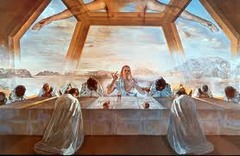
The Last Supper 1955 9 x 5 ft

answer
Salvador Dali -evangelical looking -mysterious -12 people -all bowing except Jesus -mountains in background -guy in gold to the right of Jesus
question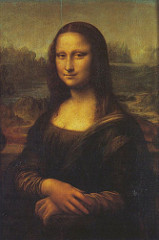
Mona Lisa 1503-1506 30 x 21 in

answer
Da Vinci -half-length portrait and depicts a woman whose expression is often described as mysterious. Leonardo cleverly drew at the level of the sitter's eyes. - The famous smile is a visual representation of the idea of happiness suggested by the word \"gioconda\" in Italian. Leonardo made this notion of happiness the central motif of the portrait. -The middle distance, on the same level as the sitter's chest, is in warm colors. Men live in this space: there is a winding road and a bridge. This space represents the transition between the space of the sitter and the far distance, where the landscape becomes a wild and uninhabited space of rocks and water which stretches to the horizon. -Leonardo da Vinci began painting the Mona Lisa in 1503 (during the Italian Renaissance). He is thought to have continued to work on it for three years after he moved to France and to have finished it shortly before he died in 1519. -Leonardo took the painting from Italy to France in 1516 when King François I bought the painting for 4,000 ekes and kept it at Fontainebleau, where it remained until given to Louis XIV and was moved to the Palace of Versailles. -no jewelry on woman, though she is upper class -pyramid form
question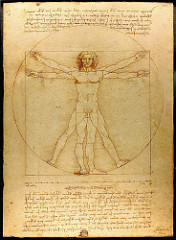
Vitruvian Man 1487-1492

answer
Da Vinci -Very little is known about Leonardo's apprenticeship in Verroccio's workshop, but the short account provided by Vasari confirms that it included architectural and technological design, according to a concept that was being revived on the model of Vitruvius. -Marcus Vitruvius was a Roman architect in 1 BCE and authored the famous treatise on architecture entitled De Architectura. His book was the authority on these subjects up through the Renaissance, and Leonardo's access to Vitruvius' treatises initiated his own version of the Vitruvian man in his notebooks. -Renaissance architects seem to have truly believed that \"Man is the measure of all things.\" Many appropriations of the Vitruvian man utilize him as representative of mankind, in general, or of the perfect man. He is often referred to as \"The Universal Man.\" -Leonardo's famous drawings of the Vitruvian proportions of a man's body first standing inscribed in a square and then with feet and arms outspread inscribed in a circle provides an excellent early example of the way in which his studies of proportion fuse artistic and scientific objectives. -He presents one of his simplest illustrations of a shifting 'centre of magnitude' without a corresponding change of 'centre of normal gravity' by overlaying the circle and the square image on top of each other to from one image. -This image provides the perfect example of Leonardo's keen interest in proportion. In addition, this picture represents a cornerstone of Leonardo's attempts to relate man to nature. Thus, he showed the belief that the workings of the human body is an analogy for the workings of the universe. -circle and square theory -golden ratio
question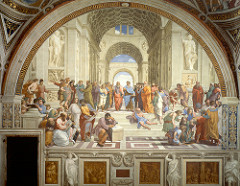
School of Athens 1510-1511 6 x 8 m

answer
Raphael -gathering of imp. Greek philosophers -Raphael painted in the style of Fresco, (painting on wet plaster). This makes the paint fuse with the plaster to create a more durable painting. This technique is very tricky because the artist has to decide how much he can paint in a day and only plaster that part. -It is one of a group on the four walls of the Stanza that depict distinct themes of knowledge, each identified above by a separate to do with putti bearing phrases for Philosophy, Poetry, Theology, and Law, which each painting below depicts. -The \"School of Athens is done in a pyramidal composition which is very characteristic of Raphael and the High Renaissance. -Raphael uses mostly natural colors with lots of browns and grays. He uses some orange and blue but mostly very earthly tones. Raphael did not use bright colors because he intended the mood to be more solemn. -All characters in are doing something. This indicts a great sense of motion which is visible in the poses of the figures. -The center figures are the Greek philosophers Plato and Aristotle that represent the two main thoughts that influenced the Italian Renaissance. Plato is painted as Da Vinci on the Left with his finger toward heaven. This pointed finger was so consistent in Da Vinci's paintings that Raphael painted him with his finger up. Aristotle is holding the book Ethica and pointing his hand to the earth. -The greek philosopher Diogenes who founded the Cynic School is shown laying on the stairs with a cup of wine. -Figure with head on fist leaning on marble slab with pen and paper, known as the pensieroso, or the thinker. Some believe this is Hercules the mythical son of Zeus. -Alcibades (in Armour on left) and Socrates (in Green). -gods and goddesses adorning the walls
question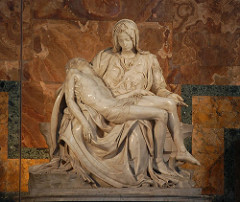
Pieta 1498

answer
Michelangelo -On a piece of marble personally chosen in the pits of Carrara, Michelangelo represents the isolated aspects of the Virgin Mary holding in her arms the body of the Christ right after it was taken down from the Cross. -According to an iconography that, during this period, had found a large consensus on the other side of the Alps. Also in the finishes of the drapes, with translucent effects of accentuated by the way in which the light seemed to caress the marble superficies. -Michelangelo supports the body on a massive lap with its draperies. While the sheer beauty of the folds, distracts us from the realization that the Virgin, if imagined standing, would be a grotesquely proportioned giantess. -In 1498, Michelangelo, only 22 years old, writes a contract, guaranteed by Jacopo Galli, with the French Cardinal of San Dionigi, for the realization, within a year, of a \"Pietà\" (pity) in marble destined to be placed in the Basilica of San Pietro. -Laszlo Toth damaged the Pieta with a hammer on May 21, 1972, while screaming \"I am Jesus Christ - risen from the dead.\" On January 29, 1973 he was declared by a Rome court be put in a mental hospital for at least two years. Vatican announced that the team of restorers attempting to repair the damage, discovered a unknown secret signature of Michelangelo on the palm of the Virgin's left hand - an \"M\" fashioned from the skin lines reproduced in marble.
question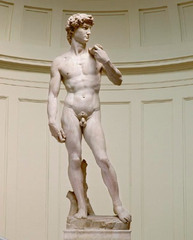
David 1501-1504 17 ft (cut from 18 ft)

answer
Michelangelo -Cast over his shoulder is David's sling, and the stone is clutched in his right hand, his veins in chief anticipation of the fight. -Michelangelo's David depicts the ideal youth who has just reached manhood and is capable of great physical and intellectual feats, which is part of the Classical tradition. -Michelangelo poses David at the moment he faces the giant, with the deed before him. He believed this was the moment of David's greatest courage. -Michelangelo's David is based on the artistic discipline of disegno, which is built on knowledge of the male human form. Under this discipline, sculpture is considered to be the finest form of art because it mimics divine creation. -Because Michelangelo adhered to the concepts of disegno, he worked under the premise that the image of David was already in the block of stone he was working on — in much the same way as the human soul is found within the physical body.
question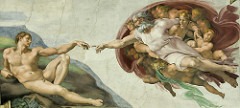
The Creation of Adam 1511-1512 45 x 120 ft

answer
Michelangelo -God is depicted as an elderly bearded man wrapped in a swirling cloak that he shares with some cherubim, with his left arm wrapped around a female figure and right arm outstretched from his own finger into that of Adam. -God's right arm is outstretched to impart the spark of life from his own finger into that of Adam, whose left arm is extended in a pose mirroring God's. -His left arm is wrapped around a female figure, normally interpreted as Eve, who is not yet created and, figuratively, waits in heaven to be given an earthly form. -Famously, Adam's finger and God's finger are separated by a slight distance, taking about three of the four years to paint. -The background figures and shapes portrayed behind God appeared to be an anatomically accurate picture of the human brain, including the frontal lobe, optic chiasm, brain stem, pituitary gland, and the major sulci of the cerebrum. -Alternatively, it has been observed that the red cloth around God has the shape of a human uterus and that the scarf hanging out, colored green, could be a newly cut umbilical cord. -What is usually interpreted from this particular scene is that Adam is not being physically created, but is in the process of receiving something momentous, yet subtle, from the hand of God. -Adam's languid posture appears to be one of near mindless repose, whereas the figure of the Creator fairly bristles with energy. -The composition enables the viewer almost to perceive the passage of a spark jumping the gap between the outstretched, not quite touching, fingers. -The outline of the human brain in the Creation of Adam may then be interpreted as the artist's pictorial declaration of his belief equating the divine gift of intellect with that of the soul. -One can notice that Adam himself forms an ellipse, but only an incomplete one: he needs God's soul-giving touch for him to complete himself as a being.
question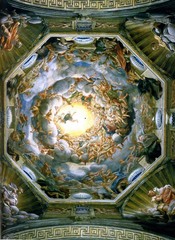
Assumption of the Virgin 1526-1530 36 ft

answer
Correggio - Italian painter, named after the small town in Emilia where he was born. Little is known of his life, but his paintings suggest under whom he may have formed his style. -Correggio shows echoes of Mantegna, Costa, and Leonardo, he also adopted Costa's pearly Ferrarese coloring and in his first documented work, Leonardo's characteristic gesture of the pointing finger. -In the commission six years later for an Assumption of the Virgin in the dome of Parma Cathedral he used the same principle, but on a much larger scale and with still more daring foreshortening. -In the Assumption, Correggio created a dazzling illusion: the architecture of the dome seems to dissolve billowing upward to accompany the Virgin as she soars into heaven. -The Virgin is circled by a network of apostles, patriarchs, and saints, all emerging from the clouds. His sensual paintings were largely influential on baroque artists.
question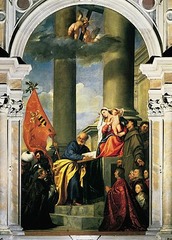
Pesaro Madonna 1519-1526 16 x 9 ft

answer
Titian -The picture was intended as a token of thanksgiving for a victory over the Turks by the Venetian nobleman Jacopo Pesaro, and Titian portrayed him kneeling before the Virgin while an armored standard-bearer drags a Turkish prisoner behind him. -St. Peter and the Virgin look down on him benignly while St Francis, on the other side, draws the attention of the Christ Child to the other members of the Pesaro family, who are kneeling in the corner of the picture. -The whole scene seems to take place in an open courtyard, with two giant columns which rise into the clouds where two little angels are playfully engaged in raising the Cross. -Titian's contemporaries may well have been amazed at the audacity with which he had dared to upset the old-established rules of composition. They must have expected, at first, to find such a picture lopsided and unbalanced. Actually it is the opposite. The unexpected composition only serves to make it gay and lively without upsetting the harmony of it all. The main reason is the way in which Titian contrived to let light, air and colors unify the scene. -The idea of making flag a mere counterbalance the figure of the Holy Virgin would have shocked an earlier generation, but this flag, is such a stupendous piece of painting that the venture was a complete success.
question
An Allegory with Venus and Cupid mid 1500s 57 x 46 in
answer
Bronzino -An Allegory with Venus and Cupid is a picture of singular beauty, in which a nude Venus is kissing with Cupid. Other figures include Pleasure and Play, and on the other side, Fraud, Jealousy. -The two characters Venus and Cupid are identifiable by their attributes, as is the old man with wings and an hourglass who must be Time. -This picture reflects Bronzino's interest in conventional Petrarchan love lyrics as well as more bawdy poetic genres as shown by the romanticism of not only his time but also the artwork. -The erotic yet erudite subject matter of the painting was well suited to the tastes of King Francis I of France, who received it as a gift from Cosimo I de' Medici, ruler of Florence, by whom Bronzino was employed as court painter.
question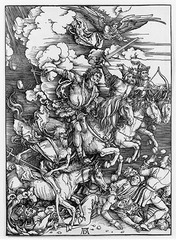
Four Horsemen of the Apocalypse 1497-1498 15 x 11 in

answer
Durer -The four horsemen of the apocalypse are described in Revelation chapter 6, verses 1-8. The four horsemen are symbolic descriptions of different events which will take place in the end times. (Riders in order from back to front). -This first horseman of the apocalypse likely refers to the antichrist, who will be given authority and will conquer all who oppose him. \"Its rider held a bow, and he was given a crown, and he rode out as a conqueror bent on conquest.\" (Revelation 6:2) -The second horseman of the apocalypse refers to terrible warfare that will break out in the end times. \"Then another horse came out, a fiery red one. Its rider was given power to take peace from the earth and to make men slay each other.\" (Revelation 6:4) -The third horseman of the apocalypse refers to a great famine that will take place, likely as a result of the wars from the second horseman. Food will be scarce, but luxuries such as wine and oil will still be readily available. -The fourth horseman of the apocalypse is symbolic of death and devastation. The fourth horseman of the apocalypse will bring further warfare and terrible famines along with awful plagues and diseases.
question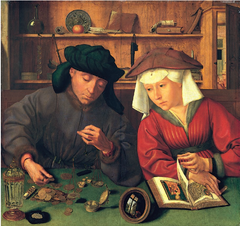
The Banker and His Wife 1514 33 x 45 in

answer
Massys -This dazzling image is probably based on a lost painting (formerly in Milan) by Jan van Eyck (ca. 1390-1441), one of the earliest representations of money handling in European art. -Here, religious devotion and mundane wealth are set side-by-side. The banker-- probably an Italian running a Flemish branch of one of the greatest Florentine banks-- painstakingly weighs and counts a small fortune in gold. -His wife, clearly disturbed by the clinking of the coins, looks up from her devotions to the Book of Hours. These two people, representing the sacred and the profane, lean gently in toward each other, reminding us that in this era religion and business were inextricably linked. -Directly over the banker's head, an apple -- symbol of the fall of an earlier couple, Adam and Eve -- sits on a shelf, while the world that generated the banker's wealth peeks in through a shutter in the back and is reflected in a mirror in the foreground. -Rather than a descriptive work documenting the subject's profession or contemporary religious practice, this painting is an allegorical and moral work. -It is as if Massys is condemning avarice and exalting honesty, as is shown by emblems of the vanity of life and Christian symbols like the scales of the Last Judgment. -Its nature is underlined by the curiously archaic dress of the subjects, which seems to hark back to an earlier period. The mirror is a fascinating detail, reminiscent of the virtuosity of van Eyck.
question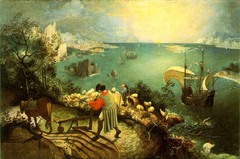
Landscape with the Fall of Icarus 1555-1556 29 x 44 in

answer
Bruegel the Elder -The picture depicts the aftermath of what happened to Icarus after his attempted escape from Crete. -Greek mythology says that Icarus's father, Daedalus, fastened Icarus a pair of wings out of wax and warned him not to fly to close to the sun or the sea. Overcome by the feeling of flying, Icarus soared upward to the sky getting too close to the sun melting his wings causing him to spiral into the sea. His legs can be seen flailing in the bottom right corner of the painting. -Icarus goes largely unnoticed in the painting perhaps to convey the point that humans turn the other way to human suffering and continue their daily routines. -Painted with oil on canvas. The painting was unknown until 1912.
question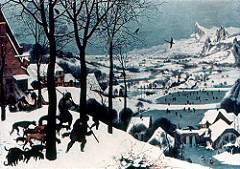
Return of the Hunters 1575

answer
Bruegel the Elder -also entitled Hunters in the Snow -Since Bruegel signed and dated many of his works, his artistic evolution can be traced from the early landscapes, in which he shows affinity with the Flemish 16th-century landscape tradition, to his last works, which are Italianate. -Rolling 'n skates and playing balls on ice was a favourite pastime in the Low Countries in the 16th Century when the winter seasons were extremely rigid. -The return of the hunters—with just a fox as their prey - preparations for pig killing (left) and wood staking (right, bridge) suggest that this painting rather refers to the sixth season, the season that anticipates winter. -Netherlanders divided the seasons into six periods, the traditional ones plus that which followed autumn and that which followed winter.
question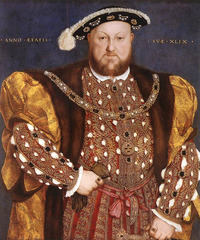
Henry VIII 1540

answer
Holbein the Younger -This is the quintessential portrait of Henry VIII. -It is so beautifully detailed that close inspection is necessary. The cloth of gold sleeve and the intricate pattern of the cloth of silver doublet are perfectly done. Real gold was used to detail the sleeve and the king's jewelry. -The portrait was done around the time of Anne Boleyn's execution, in the midst of the dissolution of the monasteries and before Henry's long-awaited son was born. -The king's figure and magnificent apparel are proof of his authority. But Holbein's portrait is not flattering; Henry appears guarded and suspicious, and quite unapproachable. This portrait is part of the Thyssen-Bornemisza collection.
question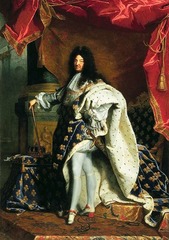
Louis XIV 1701

answer
Rigaud -The incredible tour-de-force of painting depicts a life-size Louis XIV regaled in all his ermine-lined robes of royal splendor amidst a theatrical display of scarlet drapery that can only be called \"fit for a king\". -Painted when the \"Sun King\" was no longer exactly in his prime, the 63-year-old monarch still cuts quite an impressive figure of stalwart royalty. Probably the most notable feature of the portrait is the king's elegantly graceful legs (of which he was obviously quite proud). On his feet is a pair of red, high-heeled shoes (a good 2-inches high) which he invented himself to compensate for his shortness. Complete with a massive, sheathed sword and gold walking stick. -Despite the pompous pose and the distracting magnificence of the setting, the direct gaze of the man behind the legend makes the portrait movingly human. -Rigaud's great talent rested in his uncanny ability to minimize his figure's less-attractive features while still managing to maintain a good likeness. His handling of fabric and textures is nothing less than exquisite, even though to our eyes, the whole painted extravaganza borders on the hilarious.
question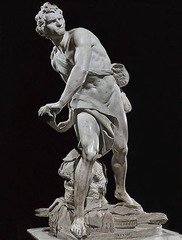
David 1623

answer
Bernini -Bernini causes the viewer to become a part of his David statue. He who looks at this giant slayer senses Goliath standing behind and above his shoulder. The viewer is almost prompted to move from the path of the projectile. The space in front of the statue becomes a part of the concept. David stands above his cast-off harp and armor. -He grimaces with determination. The features are those of the 24 year old Bernini whose patron, Cardinal Barberinik, held a mirror while the youthful sculptor made a face and carved it. -The immense tension of the twisted body conveys the force that David is ready to release. His muscular foot grips the base of the statue to withstand the body tension. The action has reached that moment when the stone is ready to be released. It is a marvel of dramatic action frozen in stone. -The immense tension of the twisted body conveys the force that David is ready to release. His muscular foot grips the base of the statue to withstand the body tension. The action has reached that moment when the stone is ready to be released. It is a marvel of dramatic action frozen in stone. -The frown of concentration and furrow in David's brow convey the sense of drama more acutely than his energetic posture.
question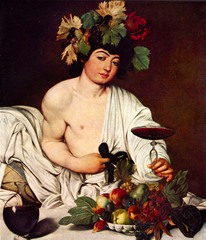
Bacchus 1595-1596

answer
Caravaggio -It is held in the Uffizi Gallery, Florence. The painting shows a youthful Bacchus reclining in classical fashion with grapes and vine leaves in his hair, fingering the drawstring of his loosely-draped robe. -On a stone table in front of him is a bowl of fruit and a large carafe of red wine; with his left hand he holds out to the viewer a shallow goblet of the same wine, apparently inviting the viewer to join him. -Bacchus was painted shortly after Caravaggio joined the household of his first important patron, Cardinal Del Monte, and reflects the humanist interests of the Cardinal's educated circle. Whether intentional or not, there is humor in this painting. -Bacchus was painted shortly after Caravaggio joined the household of his first important patron, Cardinal Del Monte, and reflects the humanist interests of the Cardinal's educated circle. Whether intentional or not, there is humor in this painting. -Bacchus' offering of the wine with his left hand, despite the obvious effort this is causing the model, has led to speculation that Caravaggio used a mirror to assist himself while working from life, doing away with the need for drawing. In other words, what appears to us as the boy's left hand was actually his right.
question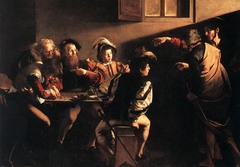
The Calling of Saint Matthew 1699

answer
Caravaggio -The painting depicts the story from the Gospel of Matthew (Matthew 9:9): Jesus saw a man named Matthew at his seat in the custom house, and said to him, \"Follow me\", and Matthew rose and followed him. -In this painting, the gloom and the canvassed window appears to situate the table indoors: Christ brings the true light to the dark space of the sitting tax-collectors. -This painting records the collision of two worlds — the ineluctable power of the immortal faith, and the mundane, foppish, world of Levi, who hunches over his money oblivious to Jesus. -Jesus' bare feet are classical simplicity in contrast with the dandified accountants; being barefoot may also symbolize holiness, as if one is on holy ground. -Following the line of Christ's left arm, it seems that Matthew is being invited to follow him into the world at large. -The two groups are also separated by a void, bridged literally and symbolically by Christ's hand. This hand, like Adam's in Michelangelo's Creation, unifies the two parts formally and psychologically. -Underlying the shallow stage-like space of the picture is a grid pattern of verticals and horizontals, which knit it together structurally.
question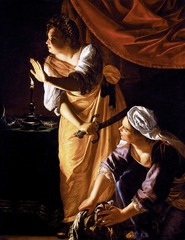
Judith and her Maidservant with the head of Holofernes 1625 6 x 5 ft

answer
Artemisia Gentileschi -Judith and her maidservant were Israelite women who saved the city of Bethulia from siege by the Assyrian army, after Judith had beguiled and intoxicated Holofernes, the Assyrian general. -The painting depicts the scene just moments after she has beheaded him in his tent. We see the maidservant stuffing the head of Holofernes into a sack as Judith keeps watch, sword to her side. -This innovative and violent rendition of the moment when Judith slices into Holofernes's neck evokes a sense of female power, control, and justice, which other painted interpretations fail to portray. -Gentileschi, from her female perspective, emphasizes that Judith's empowerment comes from mortal strength. The story of Judith is popular in the Israel religion and has been depicted by many famous painters.
question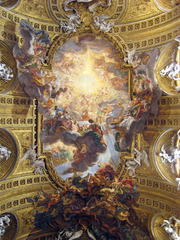
The Triumph of the name of Jesus and the Fall of the Damned 1672-1685

answer
Gaulli -Begun in 1676, the nave vault fresco, The Triumph of the Name of Jesus, was unveiled on New Year's Eve of 1679. -In this work, universally considered the culmination of baroque illusionistic ceiling painting, Gaulli masterfully orchestrated painting and sculptural details within the architectural context. He created a tumultuous scene of figures who seem to hover over or tumble into the viewer's space. -The total ensemble is one of the glories of the Counter-Reformation. Stylistically, Gaulli's works reveal the lasting influence of his Genoese heritage.
question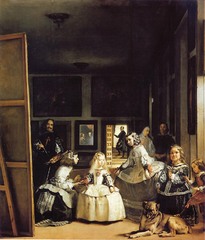
Las Meninas 1656

answer
Velazquez -draws the viewer directly into its action. In one interpretation , the viewer is apparently standing in the space occupied by King Phillip and the queen, whose reflections can be seen in the large mirror on the back wall. -(Others say the mirror reflects the canvas on which Velaquez is working). -The central focus, however, is not on the royal couple or on the artist but on the 5-year-old infanta (princess) Margarita, who is surrounded by her attendants. -No consensus exists today on the meaning of this monumental painting. It seems to have been a personal statement. Here, Velazquez proclaimed the dignity and importance of painting as one of the liberal arts.
question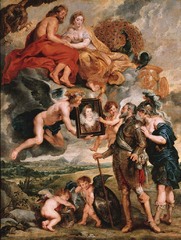
Henri IV Receiving the Portrait of Marie de Medici 1621-1625 13 x 10 ft

answer
Rubens -The gods are seated at the top of the painting in the clouds - the head of Zeus in a slightly more elevated position than that of his wife Hera. Again, dominance is conveyed through height. -The portrait of Marie de Medici is prominently displayed in the middle of the canvas; she is the centre of attention of all, even of the gods. -Although in the political hierarchy of France he was more important than she, King Henri IV is allocated only a tertiary importance as he is placed off on the side. -A personification of France is shown behind Henri in her helmet, her left hand showing support, sharing in his admiration of the future sovereignty. Rubens had a way of depicting France that was very versatile in gender in many of his paintings in the cycle. -Here France takes on an androgynous role being both woman and man at the same time. Frances's intimate gesture may suggest a closeness between Henri and his country. This gesture would usually be shared among male companions, telling each others' secret. -The way France is also dressed shows how female she is on top revealing her breasts and the way the fabric is draped adding notions of classicism. However her bottom half, most notably her exposed calves and Roman boots hints at a masculinity.
question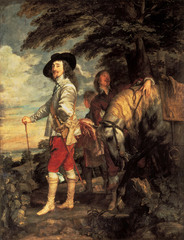
Charles I at the Hunt 1635

answer
van Dyck -The king is portrayed here as a gracious gentleman, an elegant courtier like the one Baldassare Castiglione described in his famous treatise. But this elegant portrait, despite its apparent casualness, is nevertheless a statement of royal grandeur. -The king's costume is, of course, far too luxurious for a day's hunting: wide-brimmed hat, elaborate turned-down boots, and above all the magnificent doublet on whose silvery fabric the painter displays his mastery of shimmering light effects. -He artfully enhances the figure of the king by placing him to one side, well-lit and standing out against a bright sky, while his servants are in the shade on the right. The king is looking out over a coastal landscape illustrating his kingdom's diverse riches. -His overall pose is a subtle compromise between gentlemanly nonchalance and regal assurance: one hand proudly on his hip, the other resting on his walking stick, as noble an attribute as the sword at his side. The low-angle viewpoint accentuates the king's haughty expression.
question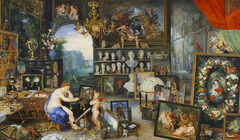
Allegory of Sight 1618 25 x 43 in

answer
Brueghel and Rubens -Oil on wood in Museo del Prado, Madrid, Spain -for which Rubens painted the figures -is among the most complex, comprising allegorical objects and figures drawn with great accuracy. -Cupid is depicted showing a painting of Christ healing a blind man. -The optical instruments - including a telescope,astrolabe, and globe - painting, statues, flowers, and jewelry are all objects perceived with the sense of sight. -Each has been painstakingly characterized with true Flemish skill, sensitive brush strokes, and bright color, so that even the. minutest of details is accurately reproduced. The series of five panels is in Prado all feature backgrounds in the manner of large opulent stage settings with extensions shown in perspective.
question
The Senses of Hearing, Touch, and Taste 1617-1618
answer
Brueghel -many people sitting down -big windows overlook a castle -many other paintings -big red curtain on the right -two birds
question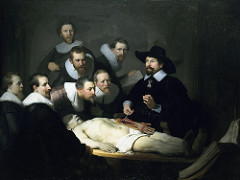
The Anatomy Lesson of Dr. Nicolaes Tulp 1632 5 x 7 ft

answer
Rembrandt -one of the most famous paintings by Rembrandt. -A detailed examination of the scene leads us to believe that Dr Tulp was demonstrating the function of the flexor digitorum superficialis. -The painting is a true lesson in physiology which is in keeping with the spirit of the 17th century, which was the century in which the modern theory of movement in physics evolved. -Radiant light from an unknown source streams down on the juxtaposed arms and hands, as Dr. Tulp flexes his own left hand to demonstrate the action of the cadaver's arm muscles. -Doctor Tulp, who was head of the surgeons' guild from 1628 to 1653, sits right of center, and the other doctors gather around to observe the cadaver and listen to the famed anatomist. -Frans Hals had activated the group portrait rather than conceiving it as a simple reproduction of figures and faces; Rembrandt transformed it into a dramatic narrative scene.
question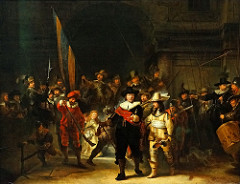
The Night Watch 1642 12 x 14 ft

answer
Rembrandt -This painting was completed at the peak of the Netherlands' golden age -- it depicts the eponymous company moving out, led by Captain Frans Banning Cocq (dressed in black, with a red sash) and his lieutenant, Willem van Ruytenburch. -With effective use of sunlight and shade, Rembrandt leads the eye to the three most important characters among the crowd, the two gentlemen in the centre and the small girl in the centre left background. -Because of a severe build-up of dirt and varnish, it was traditionally thought of as a night scene, a recent cleaning however has dispelled this idea. -Blues, greens, reds, oranges, browns, and most importantly, lemon yellow, in the uniform of the Captain, show this is a rambunctious militia group intermingled with: street urchins, a pretty young girl (bathed in a yellow glow balancing coloristically the captain's uniform), as well as numerous, seemingly unnecessary,figures melding into a dynamic composition. -Of all his great group portraits, Rembrandt is probably best remembered for this massive, 11'x14' group portrait of a band of civic guards parading through the streets of Amsterdam.
question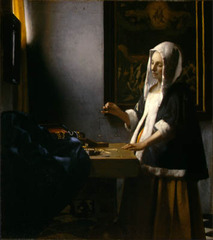
Woman Holding a Balance 1664 15 x 14 in

answer
Vermeer -overtly allegorical. -The woman stands between a depiction of the Last Judgment hung in a heavy black frame and a table covered with jewelry representing material possessions. -The empty scale stresses that she is balancing spiritual rather than material considerations. Vermeer's portrayal does not impart a sense of tension or conflict, rather the woman exudes serenity. -Her self-knowledge is reflected in the mirror on the wall. Vermeer's point is that we should lead lives of moderation with full understanding of the implications of a final judgment. The composition is designed to focus attention on the small and delicate balance being held.
question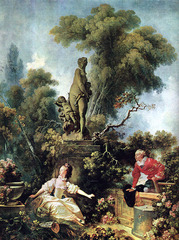
The Meeting 1771-1773 10 x 7 ft

answer
Fragonard -In 1771 the artist, Fragonard, was commissioned to paint a series of panels for the chateau at Louveciennes, the \"love nest\" of Madame du Barry, the beautiful mistress of Louis XV. -His assigned theme was \"The Progress of Love,\" and Fragonard selected to illustrate a variety of stratagems and tactics which lovers have always used. -Obviously, the \"Meeting\" depicted is a secret one between lovers due to the cautious expressions on the figure's faces, and takes place in a serene garden. -This charming picture, with its combination of imaginary landscape and aristocratic dress, is often presented as the epitome of ancient regime art.
question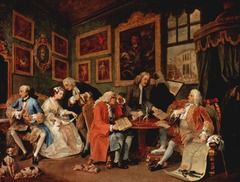
The Marriage Contract 1743-1745

answer
Hogarth -The story starts in the mansion of the Earl Squander who is arranging to marry his son to the daughter of a wealthy but mean city merchant. -It ends with the murder of the son and the suicide of the daughter. -In the first scene the aged Earl (far right) is shown with his family tree and the crutches he needs because of his gout. -The new house which he is having built is visible through the window. -The merchant, who is plainly dressed, holds the marriage contract, while his daughter behind him listens to a young lawyer, Silvertongue. -The Earl's son, the Viscount, admires his face in a mirror. -Two dogs, chained together in the bottom left corner, perhaps symbolize the marriage. -Hogarth's details, especially the paintings on the walls, comment on the action. A grand portrait in the French manner on the rear wall confronts a Medusa head, denoting horror, on the side wall. -The first of Hogarth's satirical moralizing series of engravings that took the upper echelons of society as its subject. -The paintings were models from which the engravings would be made. The engravings reverse the compositions.
question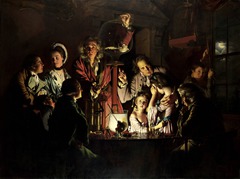
An Experiment on a Bird in the Air-Pump 1768

answer
Wright -Wright has captured a moment in history where enlightened civilization is beginning to understand how the natural universe works and how we can manipulate it to our own ends. -Sir Isaac Newton (and others), who lived during the earlier part of the 18th century heralded in this new age of discovery and scientific research. Man's relationship with nature was beginning to move away from that which could not be explained to that which will soon be understood and Wright's painting gives us a glimpse into the birth of this new age. -boy holding open to show moon symbolizes the \"moon club\"
question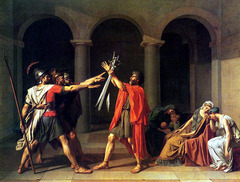
Oath of the Horatii 1784-1785 11 x 14 ft

answer
David -The sister of the Horatii brothers had been engaged to one of the Curatii. When she saw the cape of the fallen soon-to-be-husband, she started crying. -One brother killed the sister, saying that the same fate would come to every Roman who would weep for the enemy. -The Senate found the actions of the last Horatii disgusting and he was sent to the courts. He was sentenced to be whipped to death. After that, his father pleaded and said that the daughter had been killed justly. On the cries and pleas of the father, the people released the last son. The father was sacrificed for their decision. -Shows strength of men juxtaposed with the weakness of women -emblem for revolution
question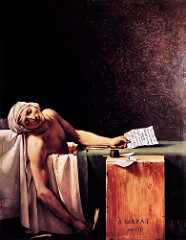
Death of Marat 1793 5 x 4 ft

answer
David -an idealistic portrait depicting the assassination of one of the leaders of the French Revolution, Jean-Paul Marat. -Marat was a prominent member of a group of people called the Jacobins, and founder of a controversial newspaper publication, 'L'Ami du Peuple' (\"The Friend of the People\"). -In Marat's right hand is the pen with which he had been writing, and draped over part of the bathtub is a cloth, which serves as a desk. By attempting to paint Marat as a \"friend of the people\", and Corday as someone who falsely appealed to his generosity at the very moment he was responding to a citizens needs. -Lying beside Marat there also lies an assignat upon a wooden crate; the assignat reads \"You will give this assignat to that mother of five children whose husband died defending the fatherland \"This document\". Near Marat's hand are the unanswerable documents of his saintliness. -Marat is slumped in the bathtub, hand outstretched, lying motionless, in a lifeless picture of tranquility and peace. Marats is portrayed in a similar pose to sculptor Michelangelo's masterpiece Pieta , which depicts Christ, arm outstretched as David depicted Marat. -The significance is the inference that Marat sacrificed himself for the good of the people, just as Christ is said to have done.
question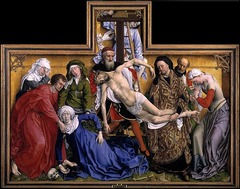
Descent from the Cross 1430

answer
Campin -Just example of limp arm
question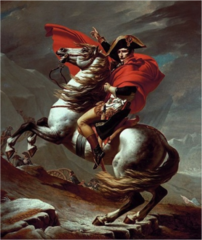
Napoleon Crossing the Saint-Bernard 1801-1805 9 x 8 ft

answer
David - the title given to the five versions of an oil on canvas equestrian portrait of Napoleon Bonaparte. -Initially commissioned by the Spanish Ambassador to France, the composition shows a strongly idealized view of the real crossing that Napoleon and his army made across the Alps in 1800. -On learning of the request, Bonaparte instructed David to produce three further versions, and a fifth version was produced by David and remained in various of his workshops until his death. -After Napoleon's rise to power and the victory at Marengo, the fashion was for allegorical portraits of Bonaparte, glorifying the new Master of France. -The composition is based on simple geometrical forms, and in spite of the dynamic aspects of the composition, the scene appears static, due in the main to the lighting with which David illuminate his subject, giving the picture the feeling of a bas-relief. -David worked using two or three layers. After capturing the basic outline with an ochre drawing, he would flesh out the painting with light touches, using a brush with little paint, and concentrating on the blocks of light and shade rather than the details.
question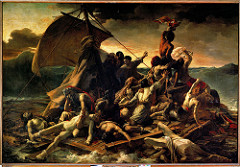
The Raft of the Medusa 1818-1819 16 x 24 ft

answer
Gericault -This painting is based upon the wreck of the Ship Medusa in 1816. When the ship beached itself on the banks of the Arguin. On board the ship were over 200 passengers. The rich on the boat were put in the life boats while everyone else was forsaken on poorly constructed rafts. -These rafts were extremely overcrowded, with little food, water, and no means of navigation. They were aproximately 65 feet by 23 feet and contained some 150 people, enough room for 3 square feet per person. -Many of the people on the rafts just floated in the water, at the mercy of the sea. - Gericault developed his composition of Hailing with the raft close to the foreground as to make the viewer feel transported onto its planks and to involve him in its drama as a participant rather than a detached observer. -The division of four dramatic groups determined the entire subsequent composition. The group of dead, dying or despondent men was the core from which the whole composition originally grew and the first group to be fully developed. -The four men who stand, alert and watchful, on the other side of the mast form a second group. The third group composed of men who struggle to rise to their feet. It is the most vividly pantomimic of the groups. -Gericault kept modifying these figures, gradually increasing their number from three to five. The fourth group consists of three men who mount some barrels at the Raft's forward end and signal to the Argus. -It is the most important of the four groups, that gives a culmination to the dramatic narrative and compositional structure of the Medusa. -The black guy's powerful torso stands out against the sky high above the horizon, the cloth unfurling in the wind from his uplifted arm and gives the scene a splendid climax.
question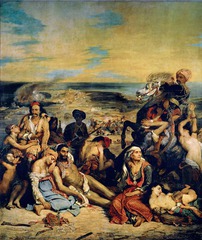
Scenes from the Massacre at Chios 1823-1824 14 x 12 ft

answer
Delacroix -The horror of war is suggested by the semi-nudity and the physical lassitude of the defeated Greeks. -The blades of the daggers are there to see, tears and blood are flowing over the bodies of a dying couple, the victorious forces in their uniforms are in shadow, suggesting the unhappy fate that awaits the captives. -The alternating patches of dark and light form an apocalyptic scene - the aftermath of a dreadful battle. -The artist, in delirium, uselessly combines atrocious scenes, sheds blood, tears out innards, paints despair and agony. -Unconventionally, however, in place of the centralized hero or object of interest of a classical composition, there is a gaping hole that allows a view on to distant hills.
question
Liberty Leading the People 1830 7 x 11 ft
answer
Delacroix -Most of Delacroix's canvases are dark in background against which he put the vibrant colors to get the desired, visually stimulant effect. The overall look of the painting is very triangularly composed. -This painting is very strong triangularly composed work with figures put mainly in two categories, the figures just lying dead in the foreground in the left-lower triangle of the canvas and the dynamically marching figures on the top-left triangle. -As the main figure of half-goddess, half-human is leading people or showing them the way to uprising, she is not shown as a soft skinned, fragile looking semi nude as other nude figures are, but a very strongly built, motivated woman, caped head to firmly striding toe, showing her stance for a certain cause. -Apart from her, no one else has got this quality of \"solidity\". The detail of her anatomy, the folds of her dress and the flying tricolor add to her personality massively. The other massive thing is smoke that is painted significantly to show the complete abolishment of the royal rule. Therefore, the volume of smoke is referring an end while the solidity of the female figure represents the beginning of something high and mighty. -All the elements of the painting let the viewer to focus on the main figure and her activity that leads to understand the importance and the fatality of the cause; the uprising, for which all the working middle class struggled hard.
question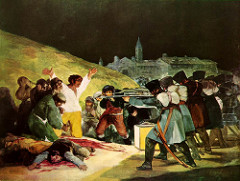
Third of May 1814 9 x 13 ft

answer
Goya -This image shows the random executions of the Spanish citizenry resulted from the fighting in the Puerto del Sol area of Madrid. A national uprising in Spain followed, and scenes such as Goya's. -The 'Third of May' was repeated throughout the Spanish countryside, as the French commanders failed to quell the national mood, and instead made it more furious. Goya had previously admired the practical freedoms the French \"enlightenment\" had promised. -Most of the victims have faces. The killers do not. This is one of the most often-noted aspects of the Third of May, and rightly so: with this painting, the modern image of war as anonymous killing is born, and a long tradition of killing as ennobled spectacle comes to its overdue end.
question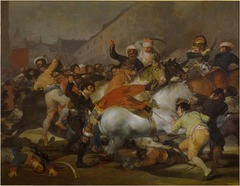
Second of May 1814

answer
Goya
question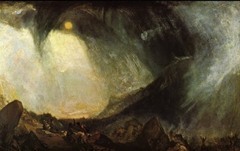
Snowstorm: Hannibal and His Army Crossing the Alps 1812 5 x 8 ft

answer
Turner -This picture exemplifies Turner's achievement in the Sublime, combining personal experience with complex historical and literary associations. The picture originated in observations of a storm in Yorkshire, though it represents Hannibal's invasion of Italy in 218 BC. -Turner does not show the General himself, but focuses instead on the distress of Hannibal's army. He thus aims at a universal, pessimistic vision of mankind, a theme Turner elaborated in poetry written to accompany this work. -Nonetheless, the picture invites a contemporary parallel, between Hannibal and Napoleon, who had crossed the Alps to invade Italy in 1797. -The storm in the painting may symbolize the downfall of empires past and present, serving as a warning against Britain's thirst for power. Turner identifies both nature and history as powerful forces against human accomplishment.
question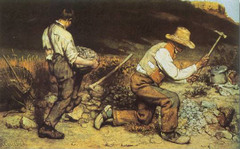
The Stone Breakers 1849-1850 5 x 9 ft

answer
Courbet -depicts two ordinary peasant workers -Courbet painted without any apparent sentiment; instead, he let the image of the two men, one too young for hard labor and the other too old, express the feelings of hardship and exhaustion that he was trying to portray. -Courbet shows sympathy for the workers and disgust for the upper class by painting these men with a dignity all their own. -Courbet's refusal to idealize or romanticize his painting seemed threatening to the society and he was attacked as a primitive or a revolutionary... and Courbet loved it. -When asked what school of painting he adhered to he retorted: \"I am a Courbetist, that's all... My painting is the only true one. I am the first and only artist of this century. The others are students and driveller.\"
question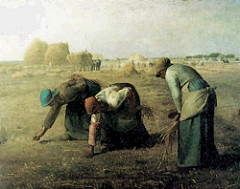
The Gleaners 1857 33 x 34 in

answer
Millet -When The Gleaners was first exhibited in 1857 it met with mixed reviews within the art world. Some commentators attacked its depiction of the rural poor, which on the one hand served as an unwelcome reminder of the marginalized poor and on the other hand were consider the kind of grotesques who had no place within the artistic realm. The comments of one critic named Paul de Saint Victor might be taken to illustrate such an attitude: His three gleaners have gigantic pretensions, they pose as the Three Fates of Poverty ... their ugliness and their grossness unrelieved.\" -Part of the shock value of Millet's painting was undoubtedly due to the fact that in the past gleaning had usually been represented in art through the Old Testament tale of Ruth the gleaner in which Ruth is characterized as a modest and virtuous example of the way to God, and not - as it was now - a statement on rural poverty.
question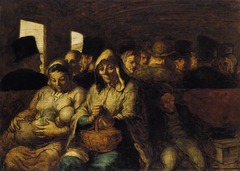
The Third Class Carriage 1862 25 x 35 in

answer
Daumier -This well-known theme reflects Daumier's sympathy for the working class. The artist was caustic in his caricatures of the bourgeoisie and politicians, but here he has created a sensitive portrayal of withdrawn, impoverished, and isolated passengers. They sit in the dimly-lit carriage, absorbed in their thoughts.
question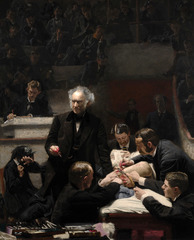
The Gross Clinic 1875 8 x 6.5 ft

answer
Eakins -The Gross Clinic depicts a heroic physician calmly performing the multiple tasks of instructing students, training assistants, and operating on a patient. -Admired for its uncompromising realism, \"The Gross Clinic\" has an important place documenting the history of medicine: -Both because it honors the emergence of surgery as a healing profession, and because it shows us what the surgical theater looked like in the nineteenth century. -Interestingly, the sex of the patient is not established by anything concrete in the painting itself. This fact makes \"The Gross Clinic\" somewhat unique, as it presents the spectator with a body that is naked and exposed, and yet is not entirely legible as male or female. -Another intriguing element of this painting is the lone woman in the painting, seen in the middle ground of the painting, cringing in distress. She can be read as a female relative of the patient, acting as a chaperone. Her dramatic figure functions as a strong contrast to the calm, professional demeanor of the men who surround the patient.
question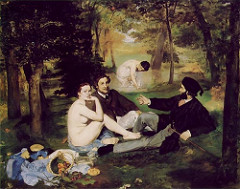
Luncheon on the Grass 1863 7 x 9 ft

answer
Manet -Le déjeuner sur l'herbe (The Lunch on the Grass in French), originally titled Le Bain (The Bath), is an oil on canvas painting by Édouard Manet. -The juxtaposition of a female nude with fully dressed men sparked controversy when the work was first exhibited at the Salon des Refusés in 1863. The piece is now in the Musée d'Orsay, Paris. -The nude, Manet's model Victorine Meurent, whose body is starkly lit, stares directly at the viewer. The two men are Manet's brother Gustave and his future brother in law, Ferdinand Leenhoff. -The roughly painted background lacks depth — giving the viewer the impression that the scene is not taking place outdoors, but in a studio. This impression is reinforced by the use of broad \"photographic\" light, which casts almost no shadows. -Manet's wife, Suzanne Leenhoff, and his favorite model, Victorine Meurent, both posed for the nude woman, which has Meurent's face, but Leenhoff's plumper body. -The style of the painting breaks with the academic traditions of the time. He did not try to hide the brush strokes: indeed, the painting looks unfinished in some parts of the scene. The nude is a far cry from the smooth, flawless figures of Cabanel or Ingres.

